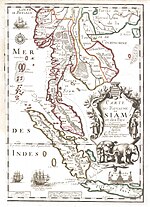Tun Sun/Tian-Sun/ Tu-Kun/Lang-ya-hsiu (頓遜/典遜/都昆/狼牙脩) (เทียนสน/หลังยะสิ่ว) | |||||||||||
|---|---|---|---|---|---|---|---|---|---|---|---|
| 52 CE[1]–c. 6th century CE | |||||||||||
![Territory of Tun Sun (1st-6th centuries CE) and the neighbors. Dark Green: Territory before gaining independence from Funan, proposed by Lawrence Palmer Briggs in 1950;[2]: 260 Light Green: As Lang-chia, territory expanded after gaining independence, proposed by George Cœdès in 1924[2]: 269](http://upload.wikimedia.org/wikipedia/commons/thumb/3/3e/Map_of_Tun_Sun_%281st-6th_centuries_CE%29.svg/250px-Map_of_Tun_Sun_%281st-6th_centuries_CE%29.svg.png) Territory of Tun Sun (1st-6th centuries CE) and the neighbors. Dark Green: Territory before gaining independence from Funan, proposed by Lawrence Palmer Briggs in 1950;[2]: 260 Light Green: As Lang-chia, territory expanded after gaining independence, proposed by George Cœdès in 1924[2]: 269 | |||||||||||
| Capital | Pong Tuk or Nakhon Pathom[3]: 52 | ||||||||||
| Religion |
| ||||||||||
| Historical era | Proto-Dvaravati era | ||||||||||
• Established | 52 CE[1] | ||||||||||
• Subdued by Funan | Before 245 CE[4]: 25 | ||||||||||
• Dependency of Funan | Before 245 – Late 5th century | ||||||||||
• Gained Independence and became Lang-chia | Late 5th century[2]: 263 | ||||||||||
• Sent the first embassy to the Chinese court | 515 CE | ||||||||||
• Disestablished | c. 6th century CE | ||||||||||
| |||||||||||
| Today part of | |||||||||||
| History of Thailand |
|---|
 |
|
|


Tun Sun (Chinese: 頓遜) or Tian-Sun or Tien-Sun (Chinese: 典遜;[5]: 32 Thai: เทียนสน[1]) or Tu-k'un/Tou-k'ouen/Ch'u-tu-k'un (都昆),[2]: 305 later Lang-chia or Lang-ya-hsiu[2]: 262–263 (郎伽/狼牙脩, หลังยะสิ่ว[6]) was a group of five ancient Mon political entities,[2]: 259 stretching from present-day lower central Thailand to the Kra Isthmus in southern Thailand and Tanintharyi Region of Myanmar.[4]: 25, 27 [5]: 38 It existed from the 1st to 6th centuries CE,[4]: 28 [2]: 259 and was said to have stretched from the east to the west coast, controlling a vital branch of long-distance maritime trade between the India Ocean and the South China Sea.[3][4][5]: 34 It was also one of the earliest Indianized-states in Southeast Asia.[4]: 28
Tun Sun remained independent until it was seized and became a vassal of Funan in the 3rd century CE,[4]: 20 [2]: 258 at least before 245 CE.[4]: 25 Tun Sun disappeared from history about the beginning of the 6th century CE,[2]: 262 when new principalities of Dvaravati emerged in central Thailand.[7]: 234 [8]
The Kingdom of Lang-chia or Lang-ya-hsiu was probably the succeeding state of Tun Sun since its first embassy, sent to China in 515 CE, claimed that the country was founded around 400 years earlier but gained independence at the end of the 5th century. Several scholars speculated that Lang-chia is situated in lower central Thailand, probably the same territory as Tun Sun. Lang-chia additionally sent embassies to China in 523 and 531.[2]: 262–263 Cœdès proposed that Lang-ya-hsiu expanded its territory eastward to modern Chanthaburi province in eastern Thailand where it bordered with Chenla.[2]: 269
Southern Lang-chia later joined Pan Pan in the south,[2]: 262–263 while its northern territory became Dvaravati and the colony of Lavo Kingdom after merging with Chin Lin following the decline of Funan in the mid-6th century.[2]: 268–270, 281 Previously, Lang-ya-hsiu was expected to be Langkasuka but according to the location provided in the Chinese text written in 636, it would be situated at the modern lower central Thailand.[6]
- ^ a b เรืองยศ จันทรคีรี (2009). ย้อนประวัติศาสตร์ 5000 ปี นอกพงศาวดารไทย สหราชอาณาจักรเทียนสน ความเป็นไป พ.ศ. 595-693 [Reminiscence at 5000 years of history outside of Thai annals: Kingdom of Tian Sun, 52 CE – 151 CE] (in Thai). สถาบันสุวรรณภูมิอภิวัฒน์. p. 166. ISBN 9789748285870.
- ^ a b c d e f g h i j k l m Lawrence Palmer Briggs (1950). "The Khmer Empire and the Malay Peninsula". The Far Eastern Quarterly. 9 (3). Duke University Press: 256–305. doi:10.2307/2049556. JSTOR 2049556. Archived from the original on 26 April 2024.
- ^ a b Cite error: The named reference
dougaldwas invoked but never defined (see the help page). - ^ a b c d e f g h Paul Wheatley (1956). "Tun-Sun (頓 遜)". The Journal of the Royal Asiatic Society of Great Britain and Ireland (1/2). Cambridge University Press: 17–30. JSTOR 25222785. Archived from the original on 26 April 2024.
- ^ a b c Gustaaf Schlegel (1899). "Geographical Notes. VII. Tun-Sun 頓遜 or Tian-Sun 典遜 Tĕnasserim or Tānah-Sāri". T'oung Pao. 10 (1). Brill Publishers: 33–38. JSTOR 4525378. Archived from the original on 26 April 2024.
- ^ a b จีรวุฒิ บุญรัศมี (2 February 2023). "'หลังยะสิ่ว' ไม่ใช่ 'ลังกาสุกะ' ตีแผ่การสนับสนุนวาทกรรมบิดเบือนประวัติศาสตร์ จากความผิดพลาดของหน่วยงานภาครัฐ". www.luehistory.com (in Thai). Archived from the original on 28 April 2024. Retrieved 29 April 2024.
- ^ Grant Evans (2014). "The Ai-Lao and Nan Chao/Tali Kingdom: A Re-orientation" (PDF). Archived from the original (PDF) on 14 March 2023. Retrieved 21 January 2024.
- ^ Stanley J. O'Connor (1970). "Dvāravatī: The Earliest Kingdom of Siam (6th to 11th Century A.D.)". The Journal of Asian Studies. 29 (2). Duke University Press. Archived from the original on 28 April 2024.
